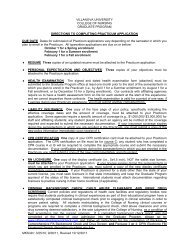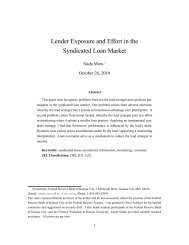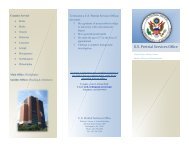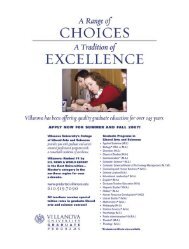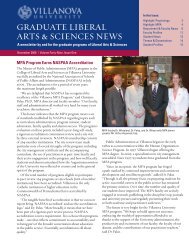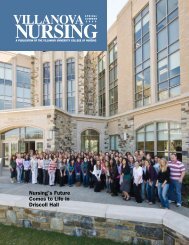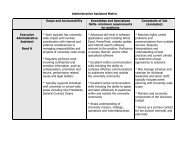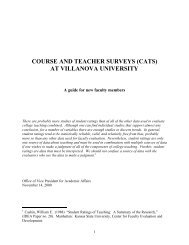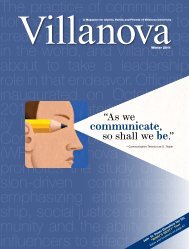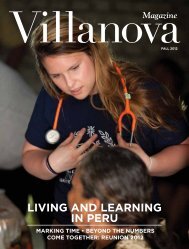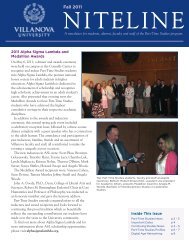Commencement 2007 - Villanova University
Commencement 2007 - Villanova University
Commencement 2007 - Villanova University
- No tags were found...
Create successful ePaper yourself
Turn your PDF publications into a flip-book with our unique Google optimized e-Paper software.
for “It would better fit your honour tochange your mind”;• Lillian Campbell (Honors Program):honorable mention for “The Gift ofGrace”;• Nicole Grbic (VSB): the MargaretCecilia Baney Award for “Lessons ofLove.” (James M. Danko, the Helenand William O’Toole Dean of the businessschool, accepted the Baney Awardfor Grbic, who was unable to attend.)The honorable mention winners wereSilvino Edward Diaz (VSB) for “Jesus andAugustine’s Contrasting Notions AboutChildhood”; Anna Maloney (Egr.) for“Circle IX: Cerchio Incurante”; and SandraP. Ogletree (A&S) for “This mortalcoil, must give us pause….”Speakers and presenters at the ceremonyincluded the Rev. Thomas Martin, O.S.A.,professor of theology and religious studiesand director of The Augustinian Instituteat <strong>Villanova</strong> <strong>University</strong>; Dr. Edwin L. Goff,associate dean of A&S and director of theHonors Program; Dr. Rebecca Cherico, anArthur J. Ennis Postdoctoral Fellow; Dr.John Immerwahr, associate vice presidentfor Academic Affairs; Catherine Staples ’86G.S., adjunct professor of English and afaculty mentor in the Honors Program;John-Paul Spiro, assistant professor and anadvising mentor in Core Humanities; Dr.Marylu Hill, assistant director of the <strong>Villanova</strong>Center for Liberal Education; andDr. Mark G. Shiffman, assistant professor ofhumanities and Augustinian traditions.Dr. Helen K. Lafferty, <strong>University</strong> vicepresident, and Dr. John R. Johannes, vicepresident for Academic Affairs, were recognizedat the ceremony for their supportof the program.PHOTOGRAPHS COURTESY DR. MAUREEN O’CONNELLWith a Paintbrush,Murals Create CommunityAt Dickinson and Bouvier streets in South Philadelphia, Cliff Eubanks created “Born Again,” oneof the city’s many murals that project a sense of hope and resurrection.BY KATHLEEN SCAVELLOIf a picture is worth a thousand words, thecommunity art murals of Philadelphiawould require a library to contain thevolumes they could fill. Many, according toDr. Maureen O’Connell, assistant professorof theology at Fordham <strong>University</strong>, would behoused in the theology section.O’Connell has been researching thetransformative affect of the city’s more than2,700 community art murals to restoresocial justice, create a sense of communityand bring desperately needed change toareas of “concentrated poverty.” She gave alecture/slide tour, titled “Art for Buildingthe City of God: Community Murals, Theologyand Social Change,” on April 20 inFalvey Memorial Library’s Main Lounge.Her presentation was sponsored by <strong>Villanova</strong><strong>University</strong>’s Center for Peace andJustice Education and the theology andreligious studies department. Dr. SuzanneC. Toton, associate professor of theologyand religious studies and a member of thecenter’s staff, introduced the speaker.Four key pointsIn her presentation, O’Connell sought todrive home four main points about thetheological quality of these murals andtheir ability to help healing begin in thecity’s communities.First, the Philadelphia murals involve arevelatory experience for the viewer. “Assuch, like any religious text or any piece ofreligious art, they invite interpretation, theycreate new awareness and they bring aboutopportunities for conversion,” she said.Second, given the predominant populationof the neighborhoods in which themurals are located, they embody or reflectideas of African spirituality followedclosely by African-American spirituality.“They give us some vision of the power tobe in these communities that can reallyinform our own understanding of theologicaltraditions or Christian traditions,”O’Connell explained.Third, the process of mural-makingembodies restorative justice. “We’re talkingmore than about just meeting people’sphysical or material needs. We’re talkingabout other things that really go hand-inhandwith enabling people to flourish,”O’Connell said.Her fourth point was that the muralsoffer a very positive and constructive rolefor religion in public discourse.The art works, organized and maintainedby the Philadelphia Mural ArtsProgram (MAP), were first commissionedas part of a 1984 city-wide Anti-GraffitiNetwork (PAGN) initiative. Philadelphianow has more murals than any other cityin the world, according to the MAP Website (www.muralarts.org). But, the muralsdo much more than beautify or ease urbanblight, according to O’Connell. They healand save lives. Laden with meaning forneighborhood residents, the larger-than-50 <strong>Villanova</strong> Magazine



